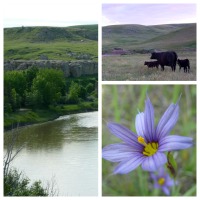Rangeland ecosystems cover approximately 7.4 million hectares in Alberta, or 43% of the province’s agricultural land base, and approximately 3.6 billion hectares worldwide. These lands – which include grasslands, as well as forested, riparian and tame pastures – provide important economic, social, and environmental benefits that are only beginning to be fully appreciated by researchers and by society at large.
In addition to providing forage for livestock production, rangelands serve as reservoirs of biodiversity and cultural heritage, provide recreational opportunities, and play an important role in conserving soils and maintaining wildlife habitat. Rangelands are being increasingly recognized for their ability to provide these and other ecological goods and services that are essential for human well being.
Despite their widespread importance, rangelands are among the most threatened ecosystems in Canada, as land uses such as annual cropping, energy exploration, recreation and urban sprawl continue to expand. Excessive or improper grazing, invasive species and climate change also threaten the integrity of remaining rangelands.
However, predicting the long-term economic, ecological, and social consequences of rangeland management decisions is a major challenge, since the characteristics of these ecosystems are both naturally variable and rapidly changing in response to human influences.
In order to preserve the value of rangelands for future generations, managers require relevant and new information about how these ecological systems function and respond to a variety of disturbances and management systems, as well as new policy tools that better reflect the broad importance of rangelands to society.

Rangelands provide an array of valuable ecosystem services.
